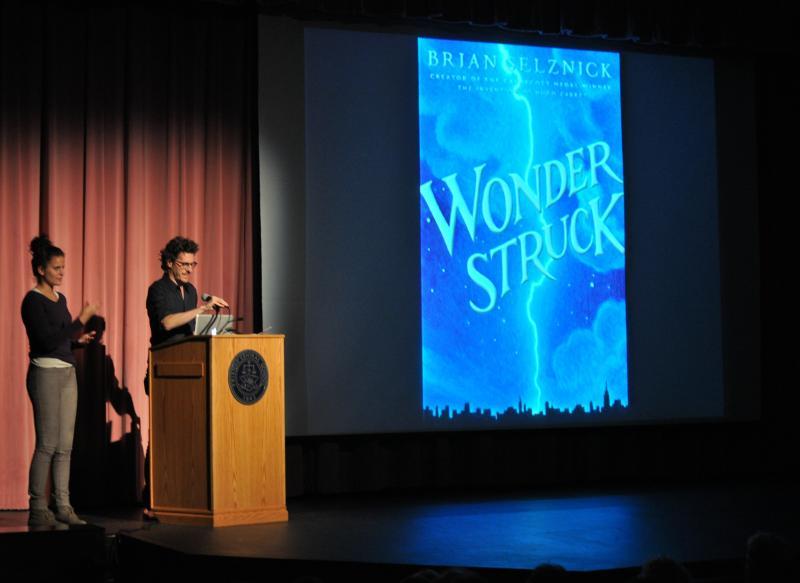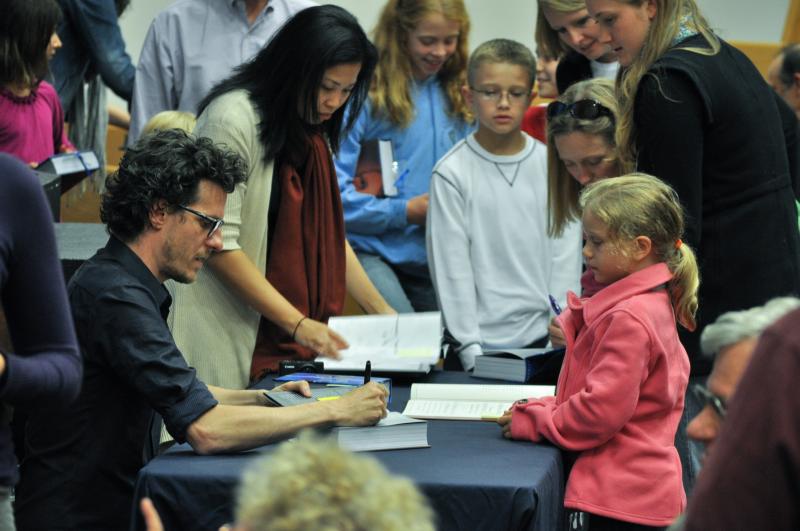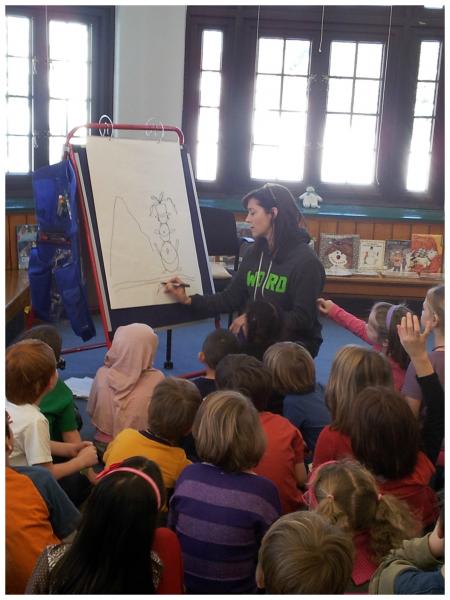Children’s Institute Panel Offers Tips on Growing Event Programming
Booksellers at last month’s Children’s Institute learned about a variety of ways to master their author events programming at the session “Expanding Your Author Events: In-Store and in the Classroom.” Suzanna Hermans of Oblong Books & Music in Rhinebeck and Millerton, New York, moderated the panel featuring Heather Hebert of Children’s Book World in Haverford, Pennsylvania; Amy Oelkers of Red Balloon Bookshop in St. Paul, Minnesota; Jennifer Corcoran, director of publicity for Little, Brown Books for Young Readers; and Jason Wells, executive director of publicity and marketing at Abrams Books for Young Readers.
When looking to host an author, either in-store or offsite, a bookseller’s request to a publisher should offer details about the bookstore, why the location would be ideal for an author visit, and how the store would support the event. However, said Hermans, “A lot of us struggle to figure out how we’re going to make our proposal stand out among the many that are received across the country for a given author’s tour.”
 When making decisions about where to send an author, many publicists, including Corcoran at Little, Brown Books for Young Readers, look to the author event grids on Edelweiss. Among the details Corcoran considers are past store events, the authors a store has hosted recently, sales figures, anecdotal information, store partnerships within the community, and whether a store reports to the New York Times, in addition to efficient travel opportunities. At Abrams, Wells relies on the company’s sales representatives, who collect tour requests from bookstores. “We try to make logical connections about where we can send somebody based on those requests,” he said.
When making decisions about where to send an author, many publicists, including Corcoran at Little, Brown Books for Young Readers, look to the author event grids on Edelweiss. Among the details Corcoran considers are past store events, the authors a store has hosted recently, sales figures, anecdotal information, store partnerships within the community, and whether a store reports to the New York Times, in addition to efficient travel opportunities. At Abrams, Wells relies on the company’s sales representatives, who collect tour requests from bookstores. “We try to make logical connections about where we can send somebody based on those requests,” he said.
As Hebert puts together author requests for Children’s Book World, which hosts upwards of 75 events per year ranging from in-store signings to book fairs to school readings, she makes sure the publicist knows about any groundwork already undertaken by staff that would contribute to a good event. “A lot of times we try to highlight if that author has a fan base that we’ve created in the area, because then we know that there’s going to be a good turnout,” she said. “We also want to make sure that if there is an author who is a super favorite among the staff that we write that, because we know that our excitement is going to get our customers excited.”
As Red Balloon’s events coordinator for two years now, Oelkers tallied 60 author visits in 2013 plus plenty of authorless events. Last year, she focused on making connections with publicists and publishers and highlighted extras that would make an event at Red Balloon stand out, such as providing an activity before the signing, like trivia, or themed refreshments.

Establishing personal connections with authors can be helpful, said Oelkers, who discovered that author Trent Reedy has a brother living in St. Paul. Combining a visit to his brother with a stop at Red Balloon is easy and budget-friendly for the publisher. Keeping a publicist in the loop about author events is important, said Corcoran. When the author is not on his or her official book tour, the publicist can still help ensure that books are ordered, promotional materials are sent, and co-op is coordinated for snacks, posters, or tickets.
“I find that publicists are also really helpful if you need to say no to an author who wants to come to your store and you know it’s not going to be a good fit,” noted Hermans.
To promote events at Children’s Book World, Hebert provides a monthly flier to area teachers for posting in school libraries or classrooms. Keeping it a monthly flier, rather than seasonal, prevents it from being covered up with other fliers on public boards, said Hebert. “We’ve been open for a long time and we only just started doing this about a year ago. I was amazed at all the new customers that found us from seeing that flier in their library,” said Hebert.
To create more buzz, Children’s Book World will incorporate other activities into the schedule, like yarn lessons from an area craft store for a reading with Mac Barnett for Extra Yarn (HarperCollins). “It made it a bigger event than it might have been if it was just a straightforward signing,” Hebert said. The store has also found success with Saturday morning events for younger kids, when parents are waiting for older children to finish up sports practices.
Oelkers sends information about events to the store’s educator e-mail list and publicizes events during the store’s book club meetings and storytimes. Older readers can be harder to grab, said Oelkers. “That is where I found that word of mouth is really essential, that you get your teen group in the store, get them excited about it, and they go and tell their friends.” Oelkers asks teens to attend events as volunteers, so they bring friends and family into the store. For younger kids, pitching an event as a morning of activities in which they also get to meet an author and take home a book can make it more appealing. When advertising on social media, “I’ve found it very helpful, too, when publicists share book trailers or all the other assets so that it’s not just a post, it’s a photo or an interview,” said Oelkers.

At Oblong, Hermans has found success hosting author panels with speakers who may be lesser-known but, as a group, create an enticing experience.
Authors like having alternative types of signings, noted Corcoran, and inviting a moderator or blogger to chat with them can keep the event fresh.
Children’s Book World has been working with a variety of locations for ticketed, offsite events. “We found that we can get auditoriums from private or parochial schools a lot of times for free or for not a whole lot of money because it’s very attractive to them to have hordes of kids come to their campus, because they could be potential students,” Hebert said. “It tends to be a win-win for the schools as well as for the store.” The store does require a book purchase by attendees, as the location often comes with a fee for maintenance or parking.
When customers purchase a ticket for an offsite event through Children’s Book World, depending on the release date of the book, the customer will get either a physical, printed ticket that they can exchange for a book at the signing, or they will get a book along with a ticket. “We make a ticket that’s the size of a bookmark,” said Hebert. “One side of the ticket is all about the event and the other side is all about store.” The store also sells books on site, both backlist titles and additional copies of the featured book.

When planning an offsite event, “Don’t be afraid to utilize volunteers,” including teens, said Oelkers. Hebert often will bring all seven of the store’s employees, plus friends and family, who help manage the venue, the line, and selling books. To keep things organized during signings, Hebert takes auditorium audiences to the author row-by-row. Other stores, noted Corcoran, do trivia or crafts while the audience is waiting. “I feel the key is to have a plan and to let people know the plan,” said Oelkers.
At events, Hebert places the store’s logo on an easel and makes sure every person leaves with a bag or bookmark featuring the store’s information. It’s important to never put the store’s logo on the front of the signing table, as it gets blocked by attendees very quickly, she reminded. Getting a store’s logo into photos, be it via buttons, stickers, or T-shirts on volunteers, is really good branding, said Wells.
Many authors will attend in-school events free of charge, but it’s important to remind the school that the author is giving up his or her honorarium “so that time is taken seriously, the teacher is prepared, and the kids are prepared,” said Corcoran.
Oelkers prepares handouts for in-school events that she sends to the school to print out. They serve as an informational flier, an order form, and as a personalization slip for the autographing line. Red Balloon requires a 25-copy minimum order from hosting schools and will leave a handful of signed copies at the school after the event for any students making late purchases. The hosting school will also have the option to take 20 percent of sales in as a fundraiser or pass along the discount to the students.

Children’s Book World sends a paper order form home with students, as Hebert discovered a dip in sales when using e-mail order forms. The store accepts orders for signed stock after events, and provides teachers or librarians with extra copies of the books — courtesy of the publisher — to help generate excitement about the visit. The store offers the school 25 percent of sales back in store credit, which librarians love, said Hebert, because they can get books for their library or classrooms.
Following school readings, Oelkers and Hebert will often welcome authors to their stores for an evening signing, and will leave the evening’s information with a teacher or librarian or have the author announce it during the event. “It’s amazing how many kids will come back. They’re so excited — they want their parents to see the author, or they want to bring their siblings to see the author, or they didn’t ask a question because they were too scared and they want to ask the question now,” said Hebert. “They feel a connection and they want to see them again.”
ABA member booksellers can now view the full educational session “Expanding Your Author Events: In-Store and in the Classroom” in four parts on the on ABA Education Curriculum page on BookWeb. Video footage of Children’s Institute events was made possible by a grant from author James Patterson.

